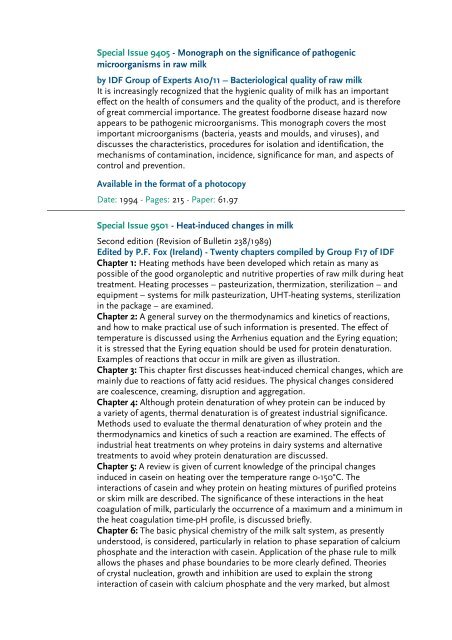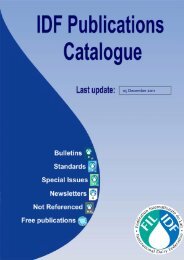Create successful ePaper yourself
Turn your PDF publications into a flip-book with our unique Google optimized e-Paper software.
Special Issue 94<strong>05</strong> - Monograph on the significance of pathogenic<br />
microorganisms in raw milk<br />
by IDF Group of Experts A10/11 – Bacteriological quality of raw milk<br />
It is increasingly recognized that the hygienic quality of milk has an important<br />
effect on the health of consumers and the quality of the product, and is therefore<br />
of great commercial importance. The greatest foodborne disease hazard now<br />
appears to be pathogenic microorganisms. This monograph covers the most<br />
important microorganisms (bacteria, yeasts and moulds, and viruses), and<br />
discusses the characteristics, procedures for isolation and identification, the<br />
mechanisms of contamination, incidence, significance for man, and aspects of<br />
control and prevention.<br />
Available in the format of a photocopy<br />
Date: 1994 - Pages: 215 - Paper: 61.97<br />
Special Issue 9501 - Heat-induced changes in milk<br />
Second edition (Revision of Bulletin 238/1989)<br />
Edited by P.F. Fox (Ireland) - Twenty chapters compiled by Group F17 of IDF<br />
Chapter 1: Heating methods have been developed which retain as many as<br />
possible of the good organoleptic and nutritive properties of raw milk during heat<br />
treatment. Heating processes – pasteurization, thermization, sterilization – and<br />
equipment – systems for milk pasteurization, UHT-heating systems, sterilization<br />
in the package – are examined.<br />
Chapter 2: A general survey on the thermodynamics and ki<strong>net</strong>ics of reactions,<br />
and how to make practical use of such information is presented. The effect of<br />
temperature is discussed using the Arrhenius equation and the Eyring equation;<br />
it is stressed that the Eyring equation should be used for protein denaturation.<br />
Examples of reactions that occur in milk are given as illustration.<br />
Chapter 3: This chapter first discusses heat-induced chemical changes, which are<br />
mainly due to reactions of fatty acid residues. The physical changes considered<br />
are coalescence, creaming, disruption and aggregation.<br />
Chapter 4: Although protein denaturation of whey protein can be induced by<br />
a variety of agents, thermal denaturation is of greatest industrial significance.<br />
Methods used to evaluate the thermal denaturation of whey protein and the<br />
thermodynamics and ki<strong>net</strong>ics of such a reaction are examined. The effects of<br />
industrial heat treatments on whey proteins in dairy systems and alternative<br />
treatments to avoid whey protein denaturation are discussed.<br />
Chapter 5: A review is given of current knowledge of the principal changes<br />
induced in casein on heating over the temperature range 0-150°C. The<br />
interactions of casein and whey protein on heating mixtures of purified proteins<br />
or skim milk are described. The significance of these interactions in the heat<br />
coagulation of milk, particularly the occurrence of a maximum and a minimum in<br />
the heat coagulation time-pH profile, is discussed briefly.<br />
Chapter 6: The basic physical chemistry of the milk salt system, as presently<br />
understood, is considered, particularly in relation to phase separation of calcium<br />
phosphate and the interaction with casein. Application of the phase rule to milk<br />
allows the phases and phase boundaries to be more clearly defined. Theories<br />
of crystal nucleation, growth and inhibition are used to explain the strong<br />
interaction of casein with calcium phosphate and the very marked, but almost



